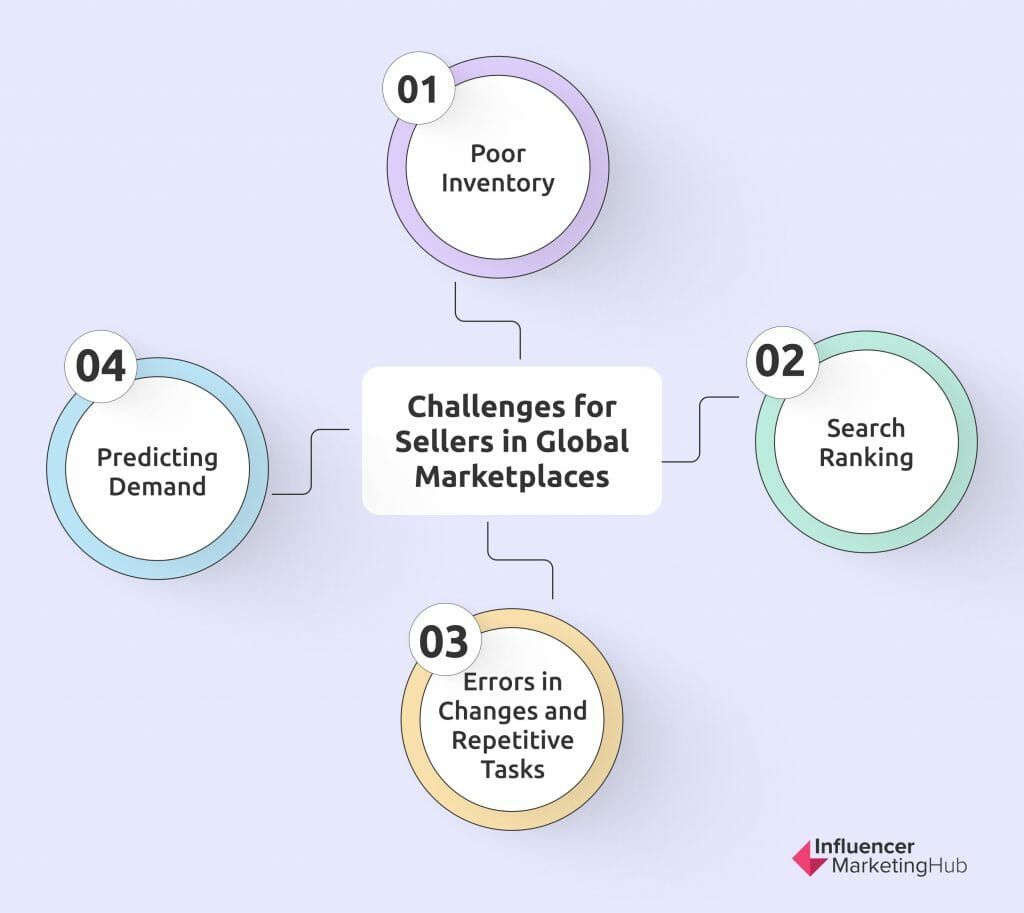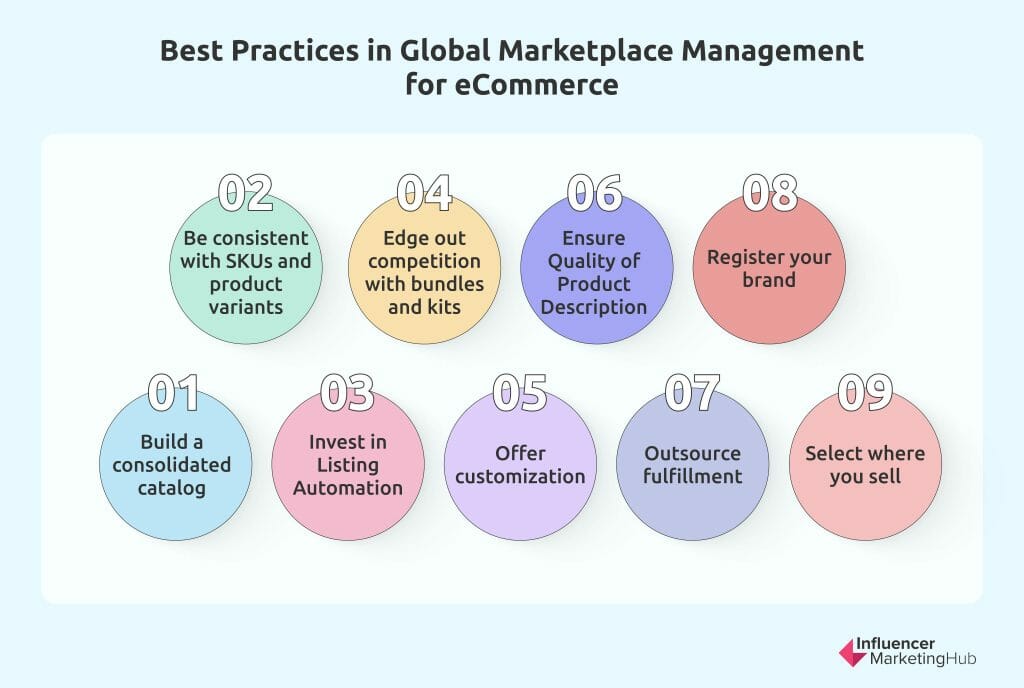Global eCommerce has dominated the market in recent years. Online marketplaces are where the customers are. Last year, there were over $5.4 trillion sales worldwide for the sector, as many have relied on marketplaces like Amazon, eBay, Alibaba, and more to shop. Shoppers find it convenient to source goods that are otherwise difficult or impossible to find in their home country. It's a win-win situation for sellers and buyers.
No doubt that sellers have to capitalize on their global eCommerce presence. Profiting through these online platforms builds your global audience and enables you to multiply profits exponentially. You're no longer limited to your geographical setting; global marketplaces bring customers worldwide to your virtual store.
Global Marketplace Management for eCommerce:
What is a Marketplace?
A marketplace is an online eCommerce platform that serves as a converging point for selling different products by different sellers. These marketplaces, like Amazon or eBay, provide a virtual shopping mall, but they do not necessarily own the goods they sell. It’s up to the individual seller to handle the inventory, manage the store, promote their products while aligning with the platforms rules, and deal with customer service directly.
Marketplaces have grown because it's so convenient for customers to access the products they need. Whether you have a direct-to-consumer brand, or a B2B wholesale business like in Alibaba, a few clicks on a device can connect customers and sellers.
All products are categorized, described, and presented in ways that can make shopping and decision-making easier for consumers. There's little effort in comparing different options, unlike if you were shopping physically, where you would have to check out different shops in order to compare goods. Plus, online checkout is secure and fast. There is little friction when consumers want to purchase goods of all kinds. Global marketplaces are helping streamline sales and delivery of products.
Challenges for Sellers in Global Marketplaces
Online marketplaces build your brand and make your customers shop your goods conveniently, but it has its own complexities.
For one, the competition is stiff. Even if the global eCommerce space is still rapidly growing, there are thousands of sellers setting up shop in these platforms each month. It's crucial to gain a heads up over other sellers.
Here are the biggest issues that sellers face when trying to elevate their eCommerce brand or store:
-
Poor Inventory
Inventory errors and mismanagement could seriously hinder your revenue. Whether there are instances of overstocking, overselling, or inconsistent inventory data, it could become a major problem if you are selling on multiple marketplaces. As a seller, getting your inventory accurate is one of, if not, the most essential thing to do.
-
Search Ranking
As mentioned, there are a multitude of sellers striving to gain top position and perform well in customers' search results. With each eCommerce platform having its own way of categorizing and organizing products for search results, sellers must take into consideration differentiating strategies for multiple channels. For example, what may work on Amazon may not necessarily be the best strategy for Walmart.
-
Errors in Changes and Repetitive Tasks
Products that are showcased on multiple platforms need to be listed again and again, which could burden you or the staff in-charge in case there's a need to edit a product description, or create a new listing. There is room for mistakes if everything is manually done without an automated app to improve the system.
-
Predicting Demand
Relating to inventory, being able to predict the number of goods to place in these multiple marketplaces can be a struggle. Supply lead times, production costs, and storage fees, not to mention the trends you have to forecast for the demand of these goods, all need to be consistently done.
Best Practices in Global Marketplace Management for eCommerce
There are certain best practices that can solve the issues in managing your eCommerce marketplace store. Differentiate your store from competitors by doing the following:
-
Build a consolidated catalog
Inventory is one of the most time-consuming and error-prone tasks. It's the backbone of your eCommerce site because unlike brick-and-mortar stores, your online stores are open 24/7 and need an updated inventory all the time.
Sellers can benefit from investing in more seamless inventory management. One way to start is to build a single source. Instead of logging into each marketplace to check inventory updates, get all your product data in one place. This creates one up-to-date reference which you can check regularly without having to check all your channels. Remember, your store isn't only selling products; it's your real-time source of sales info from which you can base your next decisions. What to restock, what marketing spend to focus on, and if any overselling happens.
Having a multichannel eCommerce providers brings all apps into one viewable and auditable place. There are two advantages: one is obviously that you have a central management source, which you can use alongside analytics and apps. Having one catalog will also help your team members access the file easily and save time having to log into each marketplace individually.
-
Be consistent with SKUs and product variants
Inventory management relates largely to how product variants are categorized in an eCommerce platform. If your product range only has a few variants, then it's a simple task to manage. However, if you have many variants in size, color, and other characteristics, then it's important to create products with unique SKUs for each one.
SKU codes usually indicate the brand, the style, color, size, plus other attributes. But SKUs are custom to your company and can be paired with a barcode to track inventory. SKUs are also handy when you need to do a quick search and edit in the listing.
While the eCommerce marketplace should prevent any duplicate SKUs across your product set, you can also do the checks and balances through an automated data management system. The best way to go about SKUs is to keep it standard across marketplaces. Your team will have a more efficient way of tracking, referencing SKUs, and editing the listing if necessary.
-
Invest in Listing Automation

Source: freepik.com
The secret to an efficient and fool-proof eCommerce marketplace management is to automate what you can, to focus on higher-level decision-making for your business. One aspect that can be easier when automated is listing. Especially if you're selling on different channels, having an automated listing system can prevent any errors that might affect your sales, as well as improve efficiency in day-to-day work.
Most importantly, an optimized listing ensures that the platform's algorithm pick up your data and maps it properly to increase your ranking chances. There are apps that can automatically categorize and format product data for you, with SEO and advanced analytics into consideration. Some offer free services, while others present premium, advanced listing automation that can accommodate bulk edits, pricing adjustments, and more.
-
Edge out competition with bundles and kits
Global marketplaces are sensitive to price parity, which means the platform itself could strike your ranking if it finds that your product has a significant price difference compared to other sites (either from your own store or another's). This can be an issue if you are in a product category with lots of competitors, because you will not have the leverage to showcase your products to the right customers.
One way to solve this issue is to offer bundles and kits. Selling a bundle means you have an entirely new inventory for that item—and a corresponding SKU with a new price point. You can then broaden your product's reach, because there will be a bundle option and an individual product option for the buyer.
Alternatively, if the idea of offering bundles and kits don’t fit in with your product or brand, simply pay more attention to pricing. To help you streamline this time-consuming task, you can check out Pacvue Commerce, an enterprise platform to help brands and sellers with advertising, sales, and intelligence. One of its many standout features is the customized reporting to help you keep track of data relating to pricing and sales.
It’s particularly useful if you list on Amazon. It can, for example, help you to work out the Buy Box weight on revenue and adjust your pricing strategy accordingly, helping you to set yourself apart from competitors.
-
Offer customization
Products that need to be customized for each order can bring that personalized touch for your customer. However, it will entail a bit more effort on the part of your inventory staff. Make sure that the customization option reflects on your listing and SKUs in order to manage the orders easily.
For instance, if you have a canvass bag with both plain option or custom printing, make sure the drop-down menu on the eCommerce channel indicates the "florals" or "abstract" or whatever the design choices are. Once the order transmits back to your system, it should reflect the features the customer wants.
-
Ensure Quality of Product Description
One of the tenets in eCommerce marketplace success is bringing the right product to the customer who is searching for it. In order to perform well on search rankings, be it on Amazon or any other platform, you must ensure that product data is complete and consistent. Customers can digest all the features in your product while they are doing Product Discovery, and compare those to other alternatives.
Of course, if yours is better presented, includes high-quality images, has complete specs and features, then your product have a higher sales rate than other options.
If you are already selling a massive number of merchandise on multiple channels, there are tools to automate this on a larger scale. As long as you are able to earn customer trust and meet the marketplace's algorithm demands, you can stay competitive.
-
Outsource fulfillment
Most global marketplaces have a third-party fulfillment program, which most sellers participate in wholly or partly. It's another way to optimize your selling procedure, because you won't have to worry about fulfilling orders on your own.
But not all channels are like Amazon that provide the feature. Some require sellers to outsource the fulfillment - to companies that can meet the platform's performance standards, such as two-day shipping and customer support. And in unfortunate instances (e.g., the pandemic's impact on Amazon halting non-essential products shipment), you would want to have a backup third-party fulfillment provider to keep your shipping process ongoing.
-
Register your brand
Global marketplace management will inevitably open you to possible counterfeiters who are offering fake goods and products in these different channels. There are stringent rules on managing an eCommerce store, but it's just a fact that there are a multitude of fraudulent sellers out there.
In order to maintain your products' trustworthiness, you may want to take time to register your brand. Amazon and Walmart, for instance, provides a Brand Registry and Brand Portal, respectively. These features help sellers gain advanced tools for marketing as well as tracking any infringement on the brand. Registering can legally safeguard your brand against unscrupulous sellers who may use it.
-
Select where you sell
Most businesses have more than one eCommerce channel established, so for newcomers, it may be tempting to just go ahead and create listings on numerous marketplaces at once. However, this can also be counterproductive, especially if that particular platform isn't the best fit for your products.
Sellers have to consider the charging schemes for each global marketplace - some charge a commission on every sale, while others have listing fees. You could examine the data and gather cost-benefit analyses for your multiple channels, and then decide if a particular eCommerce channel is worth showcasing your products, or if you should switch or take it out altogether.
Final Thoughts
Global eCommerce sales cater to about two billion online shoppers now. There is a massive potential for growth, but not without effort and savvy marketing strategies. Sellers have to strike a balance juggling different requirements and strategies all at once.
Expanding into international markets means you have a wider audience, but also more competition. These best practices can alleviate some of the bottlenecks that your brand may be encountering right now as you try to grow your eCommerce channel across platforms. Whether you have an inventory issue, want to rank higher in search results, or have been considering how to optimize SKUs, the best practices in this article may help you.
A key takeaway that encompasses all of the tips shared above is to get the right help when you need it. There's no point slaving away on inventory on your own, if you can use a tool to make it easier and fool-proof.
Dealing with product copies and listings, data analytics, and other eCommerce essentials—the demands are constant and could burn out even the most enthusiastic team. Outsourcing several steps to your global marketplace management enables you to focus on the more in-depth decision-making process, instead of the time-consuming manual tasks.
Frequently Asked Questions
What is eCommerce marketplace management?
Marketplace management lets you sell your products across different marketplaces, like eBay or Amazon. Marketplace management lets you increase your turnover thanks to easier management of your marketplace accounts.
What are the four 4 types of e-marketplaces?
These are the 4 main types of e-marketplaces:
- Independent e-marketplace, normally a business-to-business online platform
- Buyer-oriented e-marketplace
- Supplier-oriented e-marketplace
- Vertical and horizontal e-marketplaces
How do you manage your marketplace?
These management tips will ensure functioning marketplaces:
- Inventory management software
- Product discovery tools
- Leverage price management standards
- Ensure high-quality catalogs for higher conversion and lower returns
What are the 3 types of marketplace?
There are 3 main types of marketplace categories:
- Business-to-business (B2B)
- Business-to-customer (B2C)
- Peer-to-peer (P2P), or customer-to-customer (C2C)




